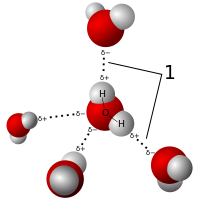
Photo from wikipedia
A series of adenine-containing polyimides (APIs) with intramolecular hydrogen bonding (HB) were prepared from N 1 -(9-(4-aminophenyl)-9H-purin-6-yl)-2-methoxybenzene-1,4-diamine (b-H-MeO-APA) and commercial dianhydrides. And a systematic comparison between intramolecular and intermolecular HB… Click to show full abstract
A series of adenine-containing polyimides (APIs) with intramolecular hydrogen bonding (HB) were prepared from N 1 -(9-(4-aminophenyl)-9H-purin-6-yl)-2-methoxybenzene-1,4-diamine (b-H-MeO-APA) and commercial dianhydrides. And a systematic comparison between intramolecular and intermolecular HB effects was made using APIs with (b-H-MeO-APIs) and without (b-H-H-API) methoxy group. FTIR indicated that the occurrence of intramolecular HB originated from the side MeO group ortho to -NH-. XRD indicated that the introduction of side group MeO and corresponding intramolecular HB could destroy the orderly stacking of b-H-H-APIs. Birefringence and polarized ATR FTIR studies showed that the groups and chains in b-H-MeO-APIs films could also be simultaneously self-arranged in the in-plane direction. In contrast, the orientation degree in the in-plane direction is generally lower than that of b-H-H-APIs. The b-H-MeO-APIs films showed lower water absorption, higher Tg, and lower CTE compared to b-H-H-APIs films, which indicates that the introduction of intramolecular HB may have some positive influence in controlling water absorption, Tg, and CTE.
Journal Title: High Performance Polymers
Year Published: 2022
Link to full text (if available)
Share on Social Media: Sign Up to like & get
recommendations!